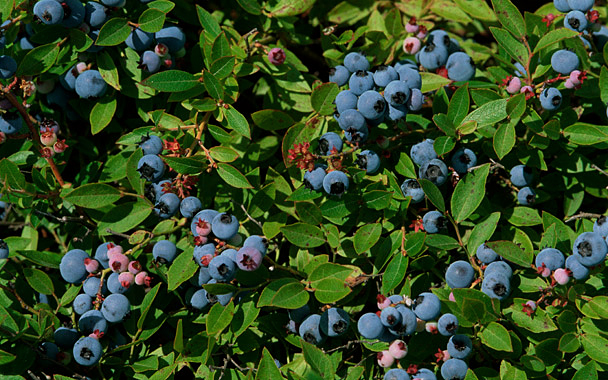If Ingmar Bergman, the soul of Nordic angst, could choose strawberries as a metaphor for the ephemeral sweetness of the world, how could I think of the accidental berry patch that appeared in our garden as anything but a gift? Bergman romanced the wildness of the strawberry, and there’s no denying that picking berries in the forest, as Gourmet’s executive food editor Kemp Minifie does in New Hampshire, is more exotic than walking down a cultivated row. She tells me that she and her family pick several quarts of blueberries each year so that there’s enough to last until the next summer. “I bring back a giant cooler filled with blueberries strapped to the roof of the car! I’ve kept them for a year in my freezer (blueberries freeze well), pulling out a cup or so every Sunday for pancakes.”
Woodland adventures aside, Stephen and I thought, why deny ourselves the metaphorical sweetness, in whatever berry form we could find it? Plants have no mind for boundaries, and when the two-year-old strawberry plants from our next-door neighbor’s garden decided to expand their real estate into our plot, Stephen and I threw down the welcome mat of compost for them.
It provoked a Bergmanesque memory for Stephen that involved a breed called ‘Sparkle.’ Enough said. He went out and got his hands on that June-bearing variety, as well as three additional strawberry cultivars including the ever-bearing ‘Tristar.’ Then he brought in some red raspberry brambles, which have already begun to leaf out in their small patch. This week our three high-bush blueberry plants arrived from Maine, a state that, with its 60,000 acres of these berries growing wild, could make even the melancholic Ingmar do a cartwheel.
Cultivating berries, however, is not a one-method-fits-all proposition, as I’ve learned from Stephen (my resident Master Gardener) and Cornell University’s Department of Horticultural Science. While all berries require well-drained soil, strawberries are fairly hardy and can grow in pretty much any soil that works for your vegetables. There are, however, a couple of rules for growing blueberries:
Plant them in an acid soil. We placed our plants about four feet apart in foot-deep holes with additional peat moss and sand, and surrounded them with a mulch of dry pine needles to bolster acidity (the ideal pH ranges from 4.5 to 5.2).
Plant at least two varieties. Blueberries are primarily cross-pollinating plants, so planting multiple varieties will help them pollinate each other. From Johnny’s Seeds, we chose a collection of Northland, Patriot, and old-cultivar Jersey high-bush plants that will stand up to the harsher climes of the Northeast. Check with your local Cooperative Extension for varieties that best suit your area of the country.
Red raspberries (hardier than yellow, purple, and black varieties) also require slightly acid soil, with a pH between 5.5 and 6.5, and the plants need to be trellised, which makes for easier pruning and harvesting. Mr. Hardscaper (aka Stephen) hauled out the posts and string to build the trellis, while Ms. Lacking Manual Dexterity went home to read—about berries.
All that reading led me to a rude awakening. Our blueberries and raspberries (and the newest strawberries) will require something of us that our already established strawberries won’t: patience. They take two years to bear fruit, which means in the first year we have to pinch off the flowers so that the plant’s energy remains in the cane or bramble. Is this another metaphor: We will be wiser if we delay the pleasures whose memory will one day carry us through our days of old age and disillusionment (that three-berry pie, for example)?
Well, okay, if Ingmar Bergman can be content with just strawberries, so can I, and I’m going to eat them all summer, in tarts, and in ice pops, and splashed with rich cream.
And I’ll keep eating them until two years from now, when we pick our newly fruiting berry bushes clean, hit the kitchen, and retire to the summer house (if I have a summer house, which I suppose I should get working on) with a groaning plate of blueberry muffin tops, a slab of rhubarb-raspberry pie, and the wild memories of our strawberry summer.
Web Resource of the Week: Garden Rant
Four smart, sassy women blog on all things gardening, from a renewed love of mâche to environmental news to interviews with top gardening pros. And they make us laugh.

